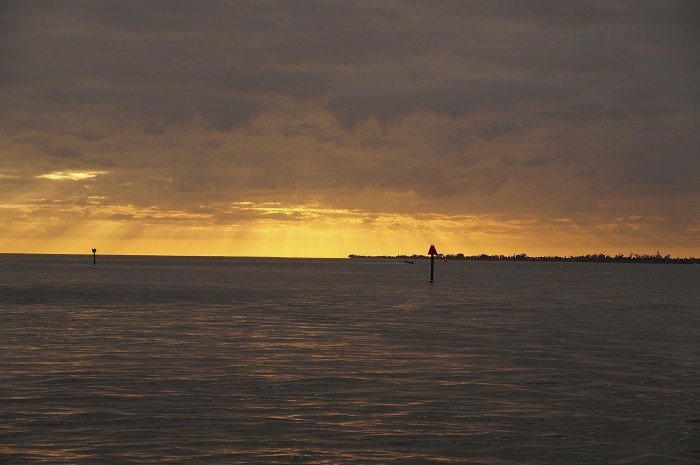Weathering Unexpected Bad Weather
A few weeks ago my wife and I planned and started a trip from Fort Myers Beach, FL to Marco Island, FL. We planned to head offshore about 20 miles so that we could get way from the sight of land and watch the moon set over the water. Sailing offshore also allows you to view the sunrise over the water. Once the moon had set planets like Venus, Mars and hundreds of stars were easy to see. According to the weather predictions the wind was to be between 10 and 12 knots over the night. On this particular trip we had along two of my wife’s friends.
The Seas Started To Build
About an hour be fore sunset we set off in the Gulf of Mexico. We were soon sailing along with a 10-12 knot breeze gazing the stars and evening planets. After about 3 hours the wind started to build up. Soon it was at 15 to 18 knots. We decided to turn to port and head on a SW course to our destination of Marco Island, FL. Unfortunately the wind increased further to 20 knots with gusts to 25 knots. The seas had also built up to between 8 and 10 feet and had become what are known in the Gulf as “confused seas”. Confused seas are like sailing in a washing machine. The boat will go up one side of a wave and then literally fall forward over the other making a loud bang as the bow lands on the other side. Over the course of the evening we motor sailed to our destination and arrived as the sun came up at Marco Island, FL.
fore sunset we set off in the Gulf of Mexico. We were soon sailing along with a 10-12 knot breeze gazing the stars and evening planets. After about 3 hours the wind started to build up. Soon it was at 15 to 18 knots. We decided to turn to port and head on a SW course to our destination of Marco Island, FL. Unfortunately the wind increased further to 20 knots with gusts to 25 knots. The seas had also built up to between 8 and 10 feet and had become what are known in the Gulf as “confused seas”. Confused seas are like sailing in a washing machine. The boat will go up one side of a wave and then literally fall forward over the other making a loud bang as the bow lands on the other side. Over the course of the evening we motor sailed to our destination and arrived as the sun came up at Marco Island, FL.
My wife and I have been living on our 38’ sail boat for almost a year. We feel confident giving you this piece of living on a boat advice. In this past year we have sailed over 1400 nautical miles. We have often been asked, “How do you handle unexpected bad weather?” Here are our tips on how to sail in a storm.
- Remain calm. This is especially true with passengers. Passengers look to the crew to keep them safe.
- Don’t argue over why you came in to unexpected weather. That can be debated later over cocktails. Remember: If you sail enough, you will get in to bad weather.
- If you have your sails up and you, the crew, or passengers are not comfortable with sailing, then take them down and motor.
- Put safety first: Make sure everyone has their life jacket on. If you are sailing at night then everyone should have the tether attached to the inside of the boat when they are topside.
- Calmly work out a plan on where to sail the boat during the bad weather. We were recently in some bad weather. We determined that heading directly to shore was dead in to the wind, and that it would take less time to motor sail slightly off the wind towards land. Again, remain calm so that you and your crew can make good choices.
- Communicate your plan of action for sailing in heavy weather to your guests.
- Exercise situational awareness. This means making sure you are watching your surroundings. For example: Conduct a 360 degree view of the water around the boat every 15 minutes. Monitor how the wind is changing over time so that you get an idea if the storm is worsening or decreasing.
- Trust your boat. Modern boats are built of fiberglass which makes them extremely buoyant.
- During long periods of bad weather, make sure that everyone on the boat takes time to rest, eat and keep warm. Maintaining high spirits while sailing in heavy weather can get you through just about any conditions.








